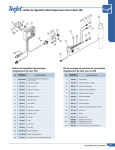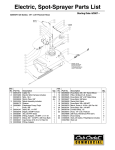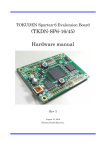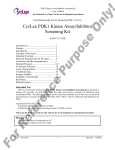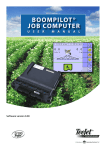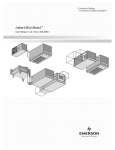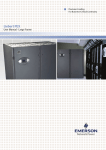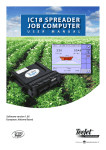Download Flex Coil a/s
Transcript
Customers manual Drycooler Models FC, IS, VB, VK, VL, VSW, VS, VT, VQ, VX & VZ Flex Coil a/s Knøsgårdvej 115 | DK-9440 Aabybro Tel.: +45 98 24 49 99 | Tel +45 98 24 49 90 E-mail: [email protected] | Web: www.flexcoil.dk Rev: sep.27—2011 NT Receipt of Goods Your dry cooler – our product – is manufactured with great care from the most appropriate materials. If you follow this manual, you will ensure a long and trouble-free operation of your dry cooler. Upon Receipt of Equipment Verify that the product and packaging are free of any damage before off-loading from the vehicle. If the equipment is damaged: Detail the extent of any damage on the Consignment Note, before signing and accepting the goods. This is very important information to include if subsequent claims are to be lodged with either the haulier or Insurers. Whenever possible photograph the equipment/damaged area(s); preferably while still on the vehicle; otherwise it may prove difficult to assign responsibility to the haulier if the damage is not noticed until after offloading from the vehicle. Immediately inform your local Flex coil a/s representative or the factory in Aabybro, Denmark. Provide; on your company letterhead; details of the damage accompanied by a copy of the signed Consignment Note and any photographs. In the case of significant damage: If significant damage is sustained to the goods, the shipment should not be accepted. Detail the extent of the damage on the Consignment Note and sign ‘goods not accepted’. Return the Consignment Note to the carrier with instructions to return the shipment to the factory. The details of the damage must be noted on the Consignment Note! In case of further onward transportation: As a minimum, always use the Flex coil a/s provided packaging/methodology for further onward transportation. Off-loading of the equipment: Via fork-lift truck or crane: Ensure that the crane operator and/or the fork-lift truck driver use adequate strops, chains, extended forks etc., to safely & securely handle the weight of the cooler. The minimum angle of any rigging for lifting by crane must always exceed 50° (see following diagram). Smaller coolers can adequately be handled via forklift, providing the standard or extended forks protrude a minimum of 20 cm from the opposite side of the product. Larger dry coolers are provided with lifting brackets for rigging via crane. Carefully remove the packaging and verify that there is no additional damage, which may not have been visible upon receipt of the product. Note: fin damage is generally only superficial and can easily be rectified. Fin combs can be purchased/supplied upon request. Dented or slightly damaged tubes should be repaired by a qualified fitter. If the cooler suffers from any severe damage to the tubes, headers etc., arrange immediate return of the cooler to the factory and notify your local Flex coil a/s representative or the factory directly. According to insurance protocol/procedures, you only have one working week to lodge a claim for any ‘unseen’ damage if this was not marked on the original Consignment Note. Assembly & Positioning Location Take adequate precautions to protect all parts of the cooler especially the header stubs & connection manifolds and avoid damage to the fins when handling the dry cooler. Note: Do not lift or manoeuvre the dry cooler via the headers/manifolds. The dry cooler should be placed with the coil tubes completely horizontal to ensure correct operation (unless stipulated otherwise by Flex coil a/s). The dry cooler should be placed on a suitable base and/or Anti-Vibration Mounts (AVM), appropriately sized for the ‘wet’ weight of the dry cooler and natural frequency implications related to operational fan speed range. The dry cooler should be bolted to the base/AVMs via M 12 bolts. Ensure that there is adequate free airflow access to the heat exchanger air inlet face to avoid air starvation issues. Ensure that there is free airflow discharge from the dry cooler to avoid air recirculation issues and subsequent under-performance. Low noise dry coolers inherently have lower fan speeds and thus lower air discharge velocities, which are more susceptible to air recirculation issues resulting from adverse prevailing wind directions. Every effort should be taken to minimise these affects by positioning the dry cooler appropriately. Strong prevailing winds can depress the discharge airflow, resulting in underperformance even in the case of horizontally mounted products. This factor is particularly important if the product is of a vertical orientation (horizontal airflow) and has low speed fans, where reverse direction ‘wind milling’ of the fans when offline, can prevent the motors from starting. Refer to the following illustrations, however if in doubt, contact Flex coil a/s for advice. Pipe Work Connection When connecting the cooler to the pipe work … Each unit is marked with arrows to indicate the inlet and outlet connection. Care should be taken to avoid applying undue torsion forces to the connections fittings and header assembly when tightening either the threaded screw connections or bolts on the flanged connections. All interconnecting pipe work – outside of the scope of supply of the dry cooler – should be independently supported and must not transfer any stress/strain to the dry cooler’s connection and header assemblies. Flex coil a/s strongly recommend the use of flexible coupling mounted between the dry cooler and supply/ return pipe work. These couplings should have sufficient flexure to allow for the associated 3D movement as a result of thermal expansion due to temperature variation. Furthermore, flexible couplings can reduce/eradicate pressure pulses generated by pumping equipment, which can in extreme cases have adverse affects upon the dry cooler’s heat exchanger tubes, resulting in leakage. If the dry cooler is mounted on AVMs (especially spring-type mounts), then the flexible couplings fitted should have sufficient additional flexure to accommodate the associated movement of the product. Prior to filling the system ensure that the drain plugs are secured and the air vents are opened. Note: these air vent and drain plugs are not suitable for filling the system. The system should ideally be filled from the lower connection to allow retained air to vent. Ensure that the system is completely void of air. Note: If micro air bubbles exist in the system circulating fluid, the thermal performance can be compromised If welding or brazing has to be conducted upon the product, ensure that the dry cooler is completely empty and ensure the air vents are open to prevent any internal pressure build-up. Flex coil a/s is not responsibility for ensuring that the dry cooler is adequately protected against frost damage. If the product has occasion to operate in close-to or sub-zero temperatures then either the circulating fluid should be dosed with an adequate anti-freeze additive or provision has to be made to either manually or automatically drain the fluid from the cooler. Note: Opening the air vent and drain connections as a means to fully drain the fluid from the dry cooler is not sufficient to fully empty all the fluid and thus prevent frost damage. In particular for large dry coolers, air pressure assisted drainage is recommended. If you have any doubts, please contact your local Flex coil a/s representative or the factory for advice. Electrical Connection All electrical equipment factory fitted or supplied by flex coil a/s is in accordance with the regulations of CENELEC, however, always verify as follows: Ensure that the supply voltage, current and frequency are all in accordance with the nameplate data of the motors fitted to the dry cooler. Check that all electrical equipment (terminal boxes, safety switches, wires and motors etc.) are intact and check the tightness of all electrical terminals, especially if the product has been subject to long road transport. IMPORTANT Flex coil a/s recommend the fitting of a suitable filter in the pipe work system to protect the pump, moving parts etc., from circulation of any dirt or debris. This filter should be checked and either cleaned or replaced at regular intervals. Note: Any solid particles held in suspension in the circulating fluid can result in erosion corrosion and consequential tube leakage, especially with copper tubes. Motors fitted to induce-draft dry coolers are designed for a maximum Air Over Motor (AOM) temperature of 70°C under normal operating conditions. Motors fitted to products with this orientation can exhibit a shorter life cycle if AOM temperatures exceed this limit. Note: Flex coil a/s can not be held responsible for motor related issues if during capacity control via fan speed regulation e.g. variable voltage or frequency inverter control, the AOM temperature exceeds this above limit. If the dry cooler system has been filled with coolant and subsequently drained for some purpose, ensure that the heat exchanger is completely empty (see above) to avoid frost damage, should the ambient temperature drop below zero whilst in this state. Ensure that dry coolers fitted with polystyrene fan deck inserts are not exposed to temperatures above 80º C under any conditions. Ensure that all fan guards are secure before starting the fan/motors. The fan guard must never be removed or loosened if the dry cooler is supplied with electrical power or indeed operational. Ensure that the fan rotation complies with the ‘directional arrows’ affixed to the fan discharge rings. Immediately following the initial start-up of the motors check for undue vibration, which may suggest possible impeller imbalance or motor bearing problems. As standard Flex coil a/s non-ATEX motors are rated as IP55 but have appropriately positioned drain holes to allow the drainage of any water resulting from internal condensation. Thus the motors are rerated as IP54. If dry coolers are fitted with motors with integral anti-condensation heaters, then upon arrival on-site these motor heaters must be immediately connected to a single phase 230V electrical supply. Note: The purpose of these low wattage heaters is to avoid internal motor water condensation and consequential motor bearing related issues. Flex coil a/s can not be held responsible for such motor problems if the above recommendations are not followed. Motors fitted to Flex coil a/s products are designed to be operational for most of their working cycle. As a consequence, during elongated ‘standstill’ periods it is recommended that the motors are started and run at full speed for a minimum period of 5 hr’s monthly to both exercise the bearings and avoid ‘bearing stiction’ issues plus thoroughly dry out the motor and terminal box if suffering from internal water condensation. USER’S MANUAL Start-up procedure Following installation – affixing to foundations, pipe work and electrical connections etc. – verify that all the fan/motors run in the same direction and appear balanced as well as not exhibiting any undue vibration. Ensure that the interconnecting pipe work does not impose any strain upon the dry cooler’s connections and that any pulsation/vibration generated by the pumps is not transferred to the dry cooler. Check for leaks! Ensure that no loose debris, leaves or paper is in the vicinity of the dry cooler, which may be sucked unto the fins, thereby blocking the coil and impairing thermal performance. It is recommended, where feasible, to conduct and record start-up thermal performance measurements in accordance with the DS/EN1048 standard. These should be filed for future reference. Such data can be used to organise a planned maintenance program to maintain design capacity when internal/external fouling of the tubes and fins becomes an issue. MAINTENANCE MANUAL Cleaning It is essential to understand that fouled or dirty fins can reduce the thermal performance of a dry cooler substantially. Regular visual inspections of the dry cooler and in particular the heat exchanger is recommended. Check for fouling of the fins by using a flash light to shine between the fins to establish the accumulation of dust, dirt or debris. If it is concluded that such fouling has impacted upon the airflow, performance or resulted in the motors drawing a higher than normal running current (Amps), the heat exchanger surface should be cleaned. Accumulation of dry dust or sand, usually on the air inlet face of the heat exchanger, can normally be simply removed by one of the following methods. Low pressure compressed air jet applied against the normal air direction of dry cooler A suitable industrial vacuum cleaner A soft hand brush. Sweep along the fins and under no circumstances across the fins. Moist, sticky accumulations or grease should be removed by means of hot water or a steam jet cleaning appliance applied against the normal air flow direction. Note: Ensure the jet of the cleaning appliance is kept at an angle of no more than 15° from vertical position, to avoid deforming the edges of the fins. Under no circumstances use organic solvents and cleaning products. If in doubt contact the manufacturer of the proposed cleaning products to confirm which cleaning agents are suitable for the dry cooler’s tube and fin material. If in doubt, contact your local Flex coil a/s representative or the factory. Avoid mechanical cleaning with any hard objects, which might damage the tubes or fins resulting in a capacity issue or perhaps even leaks. Wear and tear Generally a dry cooler is a low maintenance product where only the rotating components suffer any wear or tear. The exception is when the dry cooler is exposed to an aggressive and corrosive environment. In such a case the tube, fin and casework materials may suffer from various forms of corrosion. However, if correctly specified, the materials of manufacture should be suitable for the operational environment. Motor bearings have a nominal life cycle of 40000 hours and are normally sealed for life and thus require no maintenance under normal circumstances. However, if problems do arise they can be replaced following removal of the motor from the product and removal of the impeller from the shaft. (Refer to our bearing change instructions, available upon request). Impellers are manufactured from UV stabilised composites and are designed to last for the lifetime of the product. SAFETY PRECAUTIONS The following Health and Safety legislation and codes of practise etc. should be acknowledged. The dry cooler is designed with the design noise level as a design parameter. However, noise generated by the dry cooler can still become a nuisance and it is the responsibility of the owner of the equipment to comply with local noise constraints. Only use the coolant specified for the design of the dry cooler. Failure to do so may damage the tubes of the heat exchanger resulting in leaking tubes. If in doubt consult Flex coil a/s. The dry cooler is designed in accordance with the PED and categorised in-line with the specified design pressure. Therefore ensure that this design pressure is not exceeded. Failure to comply may result in damage to the dry cooler and could result in injury. Care should be taken when in close proximity with the heat exchanger finned surface, which comprises sharp edges and subject to injury. Use of gloves is recommended. Under no circumstances should any fans or motors be worked upon without first electrically isolating the dry cooler or fan/motor to be worked upon via its lockable safety switch. The fan guard should only be removed when the fan/motor is isolated. If ladders are used to access part of the dry cooler, they should be securely fastened to the product to avoid slippage and injury. If dry coolers are installed upon elevated support structures, safety harnesses secured to appropriate fixing points are advised. Repairs In the event that the dry cooler needs to be repaired, certain recommendations should be followed. Electrical - Always electrically isolate the whole dry cooler or specific fan/motor prior to commencing any repair work such as removing the fan guard, removal of the impeller or motor. Welding / Brazing - Ensure that the dry cooler is completely isolated and drained of coolant plus ensure that the air vents are open prior to commencing any repair work on the heat exchanger, which involves welding or brazing. Failure to do so may result in excessive internal system pressure and result in tube/pipe failure and Flex Coil a/s Knøsgårdvej 115 | DK-9440 Aabybro Tel.: +45 98 24 49 99 | Tel +45 98 24 49 90 E-mail: [email protected] | Web: www.flexcoil.dk









